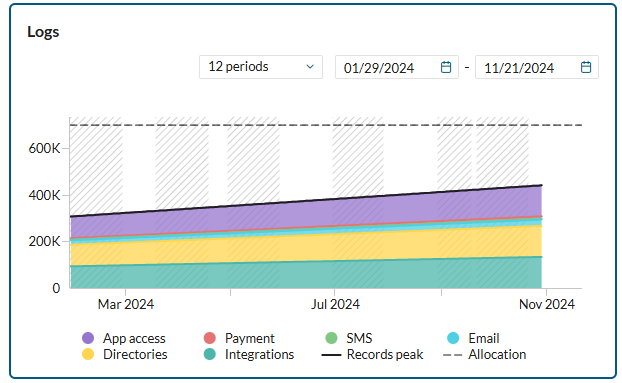Resource Usage
6 minutes to readIn Caspio, you can monitor your current usage of resources available in your account. Depending on the resource type, you can view monthly and daily usage and limits, display usage trends in charts or download data in Excel or CSV file format.
On the Usage screen, you can also add more resources to your account using the plus button![]() visible on selected usage tiles.
visible on selected usage tiles.
Accessing Usage Statistics
- On any Caspio screen, navigate to the main menu bar and click the Account icon
 → Plan and billing.
→ Plan and billing. - Select the Usage tab to view your current usage statistics. Each tile shows the resource usage in the account as well as the overall allocation.
The following states correspond to the color of usage lines:
- Green – unlimited resource allocation.
- Blue – current usage is below the allocated limit.
- Orange – the usage is close to the allocated limit.
- Red – the usage is over the allocated limit.
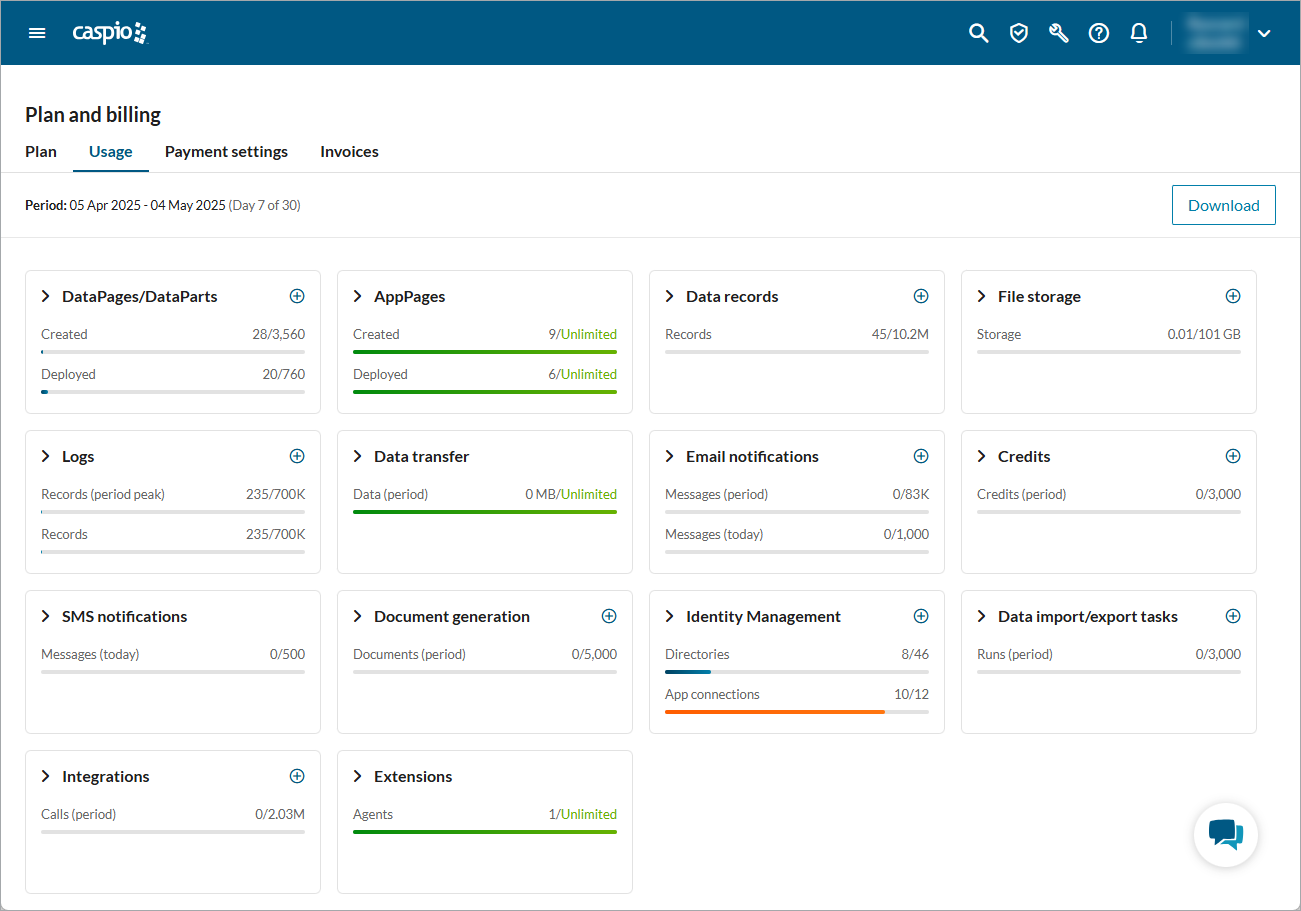
Note: Only the usage tiles of resources that are available to you are visible. For more information, see Caspio plans and pricing.
DataPages/DataParts, AppPages, Data records, File storage, Identity Management, App Connections, Extensions actions, and Logs show current usage of a resource since it has been available for the account.
Email notifications, Document Generation, Data import/export tasks, Integrations, Data transfer, and Credits show usage of a resource since the beginning of the current usage period.
- DataPages/DataParts: The number of created and deployed DataPages and DataParts. Learn more about DataPages and DataParts.
- AppPages: The number of created and deployed Flex AppPages. Learn more about AppPages.
- Data records: The number of records stored in your tables.
- File storage: Storage capacity for all files uploaded to your Caspio account.
- Logs: The sum of all records stored in the logs for: App access, Payment, SMS, Email, Directories, and Integrations. Learn more about logs.
- Data transfer: Whenever your end users submit or retrieve data through your apps, data is transferred between Caspio’s servers and the users. The accumulation of data transferred in each interaction through apps, APIs, and import/export determines your data transfer per period.
- Email notifications: The number of automatic emails generated by DataPages (Acknowledgment and Notification Emails), DataParts, Directories, Triggered Actions, and Tasks. This section shows the number of messages generated on a given day and within a certain period. Learn more about email notifications.
- Credits: The number of Credits that can be utilized by:
- SMS Notifications
SMS notifications generated by DataPages as well as triggered actions and tasks. Learn more about SMS Notifications. - AI Assistant
The number of Credits used for AI Assistant requests (including the Regenerate option). Learn more about AI Assistant. - Extensions
The number of Credits used by selected Extensions. Learn more about Extensions.
- SMS Notifications
- SMS notifications: This section shows the number of SMS messages generated on given day and daily limit. Learn more about SMS notifications.
- Document generation: The number of generated PDF documents from Document templates. Learn more about Document Generation.
- Identity Management: The number of directories created within your account and the total number of app connections in all directories. Learn more about Directories.
- Data import/export tasks: The number of Data import/export task runs in the current usage period. Learn more about data import/export tasks.
- Integrations: The number of calls utilized by REST API, Webhooks and Extensions in current usage period. Learn more about Integrations.
- Extensions: The number of Extensions actions created within your account. Learn more about Extensions.
Caspio Credits
Credits in Caspio allow you to explore key features such as SMS Notifications, the AI Assistant, and Premium Extensions. Every account includes a monthly allotment of Credits to help you test and experience these capabilities. However, these Credits are not intended to cover ongoing operational needs. If your usage exceeds the included Credits, your applications will continue running without disruption, incurring on-demand usage fees. We recommend adding Credits in advance based on your anticipated needs.
Learn more about Caspio Pricing.
Managing usage charts
Usage charts are graphical depictions of resource usage. Depending on the resource type, you can monitor daily or monthly resource usage on the chart. To view the usage chart, click on the tile of a given resource.
Selecting time range
You can select the period(s) for which you want to display the data by choosing the exact period or custom range of dates from a dropdown. For charts with multiple cycles available, background shading indicates the start and end of a given period.
Note: The available periods depend on the length of your account history.
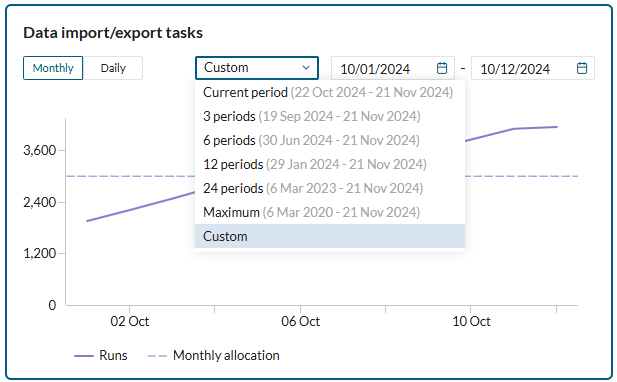
Viewing usage data against your monthly allocation
The monthly allocation line appears by default for all charts where you have a pool of allocated resources. It is possible to hide and show it. To do that, click Monthly allocation on the chart legend. Hiding the line may be especially helpful if you need to make the chart with low values but high allocation more readable.
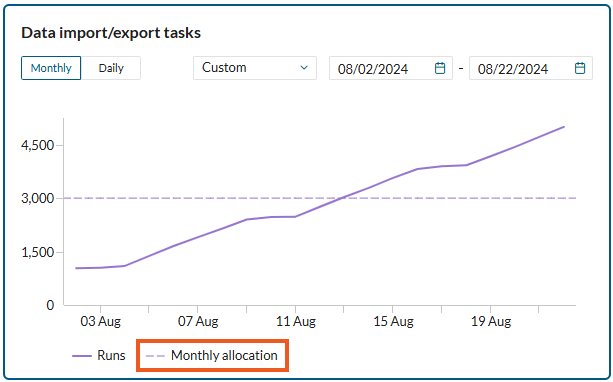
Zooming the data in and out
Select the specific area of a chart by clicking and dragging to zoom in to the lower level of granularity. You can return to the original chart view by clicking the Reset zoom button.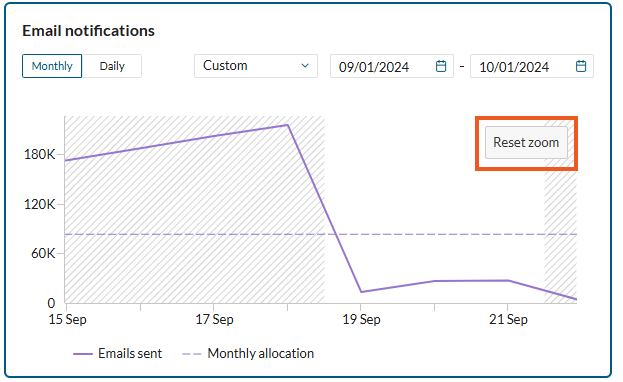
Navigating between daily and monthly usage
For selected resources, you can navigate between daily and monthly usage. Select the Daily or Monthly button to see the relevant chart.
Chart-specific options
Selected resources have extra options that are specific to the resource type. You can switch the options on and off by clicking the legend icons below a chart.
- It is possible to see separate charts for created and deployed DataPages/DataParts and App Pages. Select the Created or Deployed button to see a relevant chart.
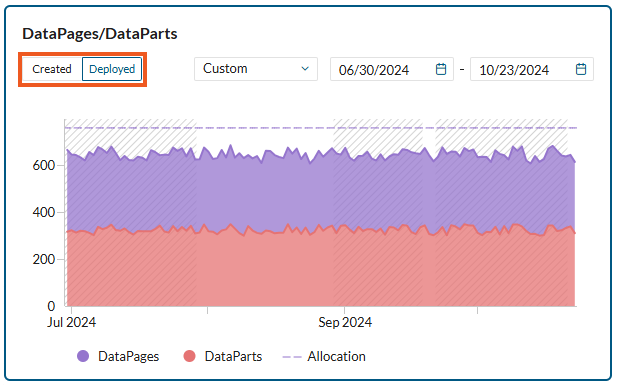
- For DataPages/DataParts, Logs, Credits, and Integrations, the area charts depicts changes in usage over time, the sum of selected resources, and the peak for a given period. You can show and hide specific data by clicking the legend.
